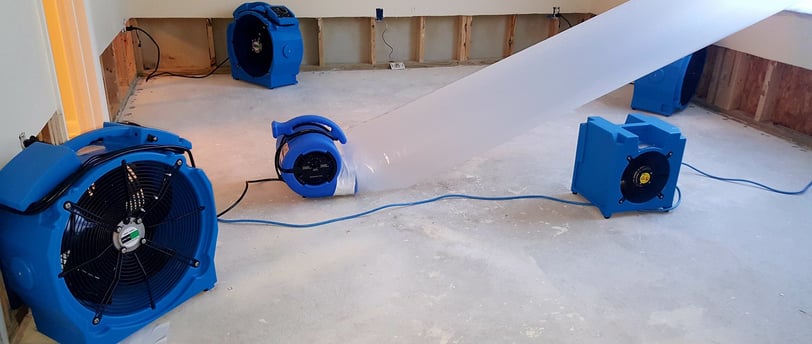Mastering Moisture: Advanced Water Extraction Methods for Swift Restoration
Advanced Water Extraction Methods
11/28/20233 min read


Introduction:
Water damage can strike swiftly and severely impact homes and businesses. Effective water extraction is the key to preventing further damage and restoring a property to its pre-loss condition. In this comprehensive guide, we'll explore advanced water extraction methods utilized by restoration specialists to tackle even the most challenging situations.
Section 1: The Importance of Rapid Water Extraction
1.1 Mitigating Structural Damage
Swift water extraction is crucial for mitigating structural damage. Water can compromise the integrity of building materials, leading to issues such as warping, swelling, and deterioration.
1.2 Mold Prevention
Timely water extraction is a powerful mold prevention measure. Mold can begin to grow within 24-48 hours, making rapid extraction essential for minimizing the risk of mold infestations.
Section 2: Assessing the Situation
Before implementing advanced water extraction methods, it's essential to assess the severity of the water damage:
2.1 Professional Inspection
Engage a certified water damage restoration specialist to assess the extent of the damage. Professionals use moisture meters, thermal imaging, and other advanced tools to identify hidden pockets of moisture.
2.2 Categorizing Water Damage
Classify the water damage based on industry standards (clean water, grey water, black water). Different categories require specific extraction methods to ensure safe and effective restoration.
Section 3: Advanced Water Extraction Equipment
3.1 High-Volume Pumps
Industrial-grade high-volume pumps are capable of extracting large quantities of water quickly. These pumps are particularly effective in the aftermath of flooding or severe water damage.
3.2 Submersible Pumps
Submersible pumps are designed to operate underwater, making them ideal for removing standing water in basements or other submerged areas. These pumps can handle both clean and contaminated water.
3.3 Truck-Mounted Extraction Units
Truck-mounted extraction units combine powerful pumps and vacuum systems mounted on specialized vehicles. These units can rapidly extract water from large commercial spaces or multistory buildings.
Section 4: Advanced Drying Techniques
4.1 Desiccant Dehumidifiers
Desiccant dehumidifiers are highly efficient in low humidity conditions. They use desiccant materials to absorb moisture from the air, allowing for faster and more thorough drying.
4.2 Heat Drying Systems
Heat drying systems accelerate the evaporation process by raising the temperature in the affected area. This method is particularly effective for drying out structural components like walls and subfloors.
4.3 Directed Airflow with Air Movers
Advanced air movers with adjustable airflow direction can be strategically placed to target specific areas, promoting faster drying. This precision is valuable in complex structures or confined spaces.
Section 5: Infrared Thermography for Moisture Detection
5.1 How Infrared Thermography Works
Infrared thermography uses thermal imaging cameras to detect temperature variations associated with moisture. This technology allows specialists to identify hidden pockets of moisture that may not be visible to the naked eye.
5.2 Benefits of Infrared Thermography
Infrared thermography is a non-invasive method for moisture detection. It helps restoration specialists create targeted drying plans, ensuring thorough and efficient water extraction.
Section 6: Containment Strategies
6.1 Creating Moisture Barriers
Containment strategies involve creating moisture barriers to prevent the spread of water and moisture. This is crucial for controlling the affected area and minimizing the risk of secondary damage.
6.2 Negative Air Pressure Systems
Negative air pressure systems help contain airborne contaminants and prevent the spread of mold spores during water extraction. This is especially important in situations where water damage involves contaminated or black water.
Section 7: Remote Monitoring and Telemetry
7.1 Real-Time Monitoring
Utilizing remote monitoring and telemetry systems allows restoration specialists to track moisture levels, temperature, and humidity remotely. This technology provides real-time data, enabling adjustments to the drying process as needed.
7.2 Data-Driven Decision Making
Remote monitoring facilitates data-driven decision-making, ensuring that the water extraction and drying process is optimized for efficiency. This is particularly valuable in large-scale restoration projects.
Section 8: Professional Expertise and Training
8.1 Certified Water Damage Restoration Specialists
Engaging certified water damage restoration specialists ensures that advanced water extraction methods are applied with precision. Specialists undergo rigorous training to stay abreast of the latest technologies and techniques in the field.
8.2 Tailored Restoration Plans
Professionals develop tailored restoration plans based on the specific circumstances of each water damage incident. This personalized approach ensures that advanced extraction methods are applied effectively.
Conclusion:
Advanced water extraction methods represent the cutting edge of water damage restoration, allowing specialists to tackle even the most challenging scenarios. From high-volume pumps and infrared thermography to sophisticated drying techniques, the tools and technologies available today enable restoration professionals to mitigate damage swiftly and efficiently. Embracing these advanced methods not only accelerates the restoration process but also minimizes the long-term impact on structures and occupants. In the hands of certified specialists, advanced water extraction is a powerful force for restoring properties to their optimal condition.
A-Z Dryout
3260 N Hayden Rd STE 210 Scottsdale. Arizona 85251
(480) 617-0978
azdryout@gmail.com
